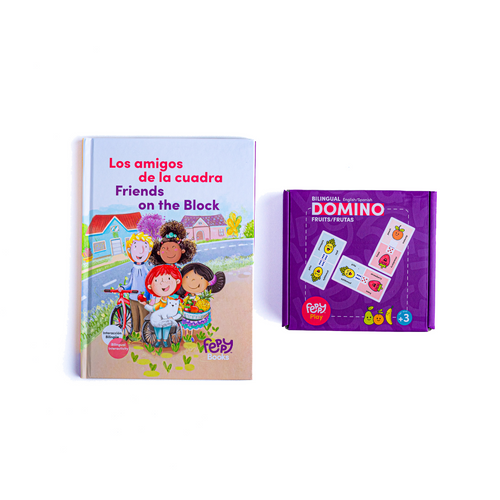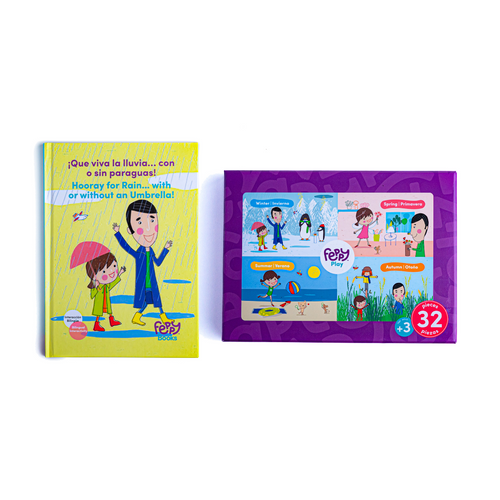
How to Teach Seasons to Kids in a Fun Way
Kids can find dreamy adventures and magical tales in everything around them. During childhood, the changing seasons serve as captivating chapters that invite children to explore and learn. As parents and educators, we hold the key to nurturing their curiosity and understanding of the world by teaching them about the beauty of nature's rhythm, all while embracing the magic of bilingual learning.
Welcome to the bilingual journey through the seasons—a delightful adventure that sparks joy, enriches language skills, and fosters lifelong learners.
Preschool-aged kids are naturally curious and eager to learn about the world around them. Your kids might be super ready to start learning when they start asking questions about why the weather changes or when they show an interest in different types of clothing for various weather conditions.

The Magic of Seasons: Nature's Colorful Canvas
Every season is like a page in Mother Nature's storybook, where colors and textures dance in perfect harmony. Teaching children about seasons is like unveiling the chapters of a thrilling adventure. It's not just about the weather changing; it's about understanding the Earth’s incredible life cycles.
How Can We Effectively Teach Our Children The Seasons In Both English And Spanish?
Creatively and enjoyably, we will always find different ways to keep the little ones learning new things and expanding their knowledge in both languages. Here are some examples:
Unveiling the Differences:
As we embark on this bilingual journey, we invite children to observe the world around them and notice the subtle shifts that mark each season. From the budding flowers of spring to the crisp air of autumn, they discover how nature transforms. In the same breath, we introduce them to the vocabulary of seasons in both English and Spanish, creating a bridge between languages.
Spot the Difference: A Bilingual Treasure Hunt
As we hop onto this bilingual rollercoaster, we're inviting your tiny tots to put on their detective hats and observe the world around them. From spring's flower parade to the chill of autumn, they're in for a journey filled with natural wonders. But here's the kicker: we're throwing in a sprinkle of English and Spanish vocabulary to spice things up.
Think of it as building a linguistic bridge between two languages while exploring the seasons.
Bilingual Puzzles That Make Learning a Piece of Cake
Learning becomes a puzzle of joy and exploration. Imagine the delight in your child's eyes as they piece together a puzzle that illustrates the fiery leaves of fall or the blooming spring flowers, all while effortlessly soaking up new words and phrases in English and Spanish like sponges. Bilingual Puzzles serve as captivating tools that engage their minds and enrich their language skills. Talk about hitting two birds with one stone!
English Spanish Coloring Calendar:
Hold onto your crayons, folks, because we're turning a splash of color into a wild language-learning adventure! With the English Spanish Coloring Calendar, children explore the months, holidays, and seasonal activities while coloring their way through the year. Each stroke of the crayon is a stroke of genius, connecting them deeper to language and culture. It's coloring with a side of seasons – a creative visual journey.
Melodies of Seasons: Singing Along with Kids' Favorites
Music has an enchanting ability to weave memories and learning together. Nursery rhymes like "Sol solecito" and "Que llueva, que llueva" become more than just songs; they're tickets to the bilingual party. Through catchy tunes and playful lyrics, your mini rockstars will absorb vocabulary like never before, all while embracing the joy of music.
Creative Adventures: Playful Learning Through the Seasons
Hold onto your hats, because it's time to let loose! Play is your child's native language, and we're using it to teach them about seasons. From indoor scavenger hunts to outdoor snowball tosses, we blend fun and education seamlessly. Children become detectives, hunting for signs of changing seasons, or architects, constructing snowmen that tell tales of winter's chill.
With each game, they're learning, creating unforgettable memories, and expanding their language horizons. Kids learn best while they’re having fun.
The Science Behind Seasons: A Cosmic Quest
We're not stopping at the fun stuff; we're diving into the nitty-gritty. Delving into the science behind seasons unveils the cosmic dance of our planet. Kids are naturally curious, and by breaking down concepts like Earth's axial tilt and the solstices and equinoxes, we're sparking their interest in the vast world beyond their sight.
Seasons Around the World: A Global Perspective
In a world that grows smaller every day, understanding different cultures is vital. We're taking your young explorers on a global adventure by exploring seasonal celebrations from diverse cultures. This isn't just about seasons; it's about broadening their horizons, nurturing empathy, and promoting respect for others. It's like a world tour without leaving your living room!
Nurturing Lifelong Learners:
As parents and educators, we have the privilege of cultivating a love for learning in children. By embracing seasons and bilingualism, we offer them keys to unlock a world of understanding, empathy, and communication. This journey is all about sparking curiosity. It's the kind of adventure that'll turn our little ones into lifelong learners who greet each season with open arms.
Benefits of teaching your kids about the seasons in two languages
Teaching our children about the seasons of the year, emphasizing their key features and differences, can provide them with significant educational and practical benefits.
Educational Benefits:
- Enhances Vocabulary: Learning about the seasons provides a rich vocabulary-building opportunity. Children can learn words related to each season, such as "spring," "summer," "fall," and "winter," as well as associated terms like "blossom," "snowflake," "sunshine," and "rain."
- Improves Observational Skills: Teaching seasons encourages kids to become keen observers. They learn to notice changes in the environment, such as the leaves changing colors in autumn or the days getting longer in spring.
- Introduces the Concept of Change and Patterns: Understanding seasons helps children grasp the concept of change and cyclical patterns. It shows them that change is a natural part of life, just like the changing seasons.
Practical Benefits:
- Preparation for Outdoor Activities: Knowing the seasons helps children prepare for outdoor activities. They'll understand when it's time for swimming in the summer, building snowmen in the winter, or jumping in puddles during spring showers.
- Understanding Clothing Choices: Seasons also teach kids about the appropriate clothing choices for different times of the year. They'll learn that shorts and t-shirts are perfect for summer, while warm coats and boots are essential in the winter.
- Instills a Sense of Rhythm in Nature and Life: Teaching seasons introduces kids to the rhythm of nature and life's cyclical nature. It helps them connect to the world around them on a deeper level.
The seasons are like Mother Nature's gift-wrapped surprises to the Earth's endless cycles, and they invite us to celebrate diversity and change. Through playful activities, bilingual tools, and the magic of creativity, we can guide our children on a journey that enriches their minds and hearts.
So let's embark on this adventure together, hand in hand with our little explorers, and watch as they flourish into bilingual learners who embrace the beauty of every season.
Join us in the bilingual whirlwind through the seasons, where every moment is an opportunity to giggle, learn, and embrace the magic of it all!









